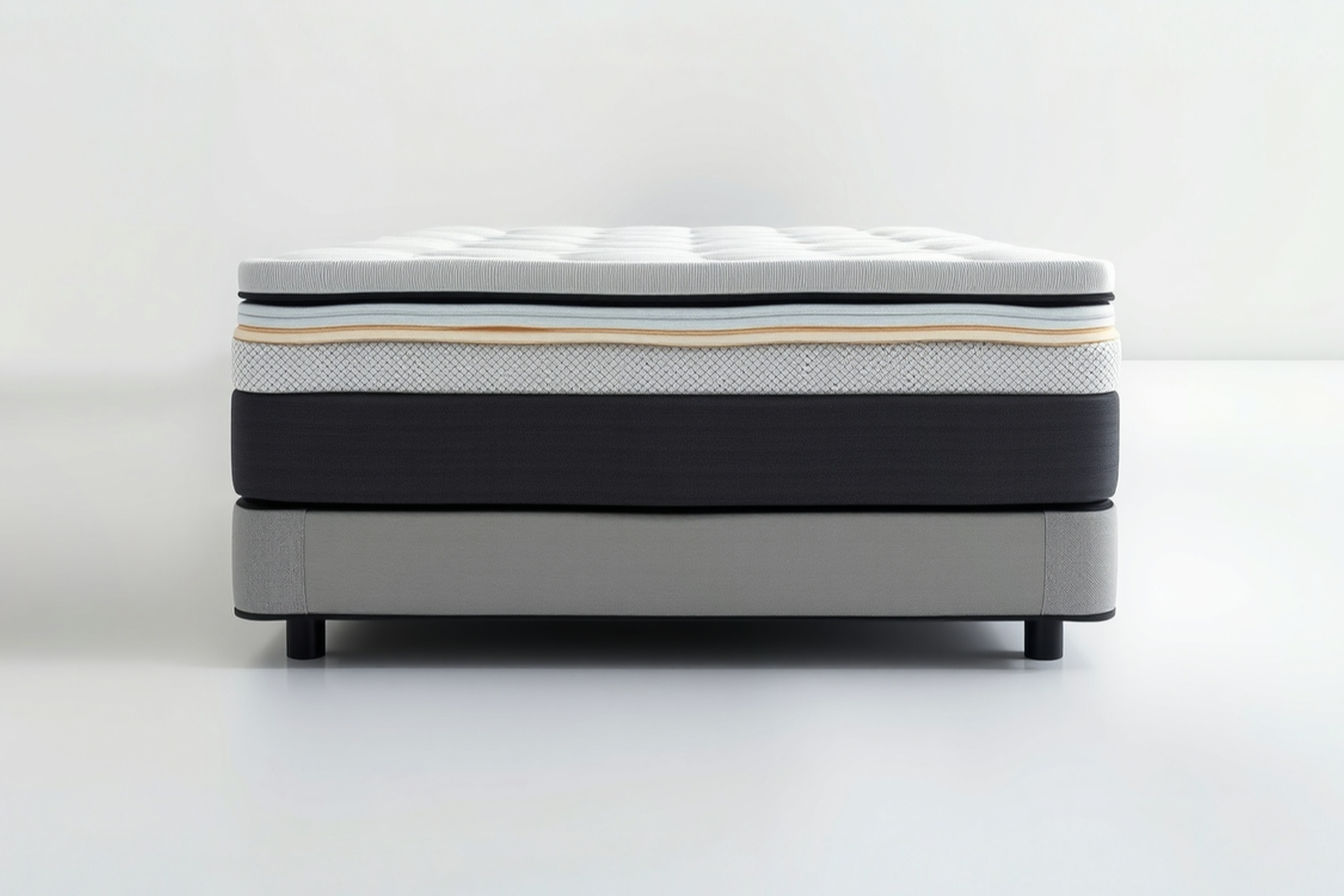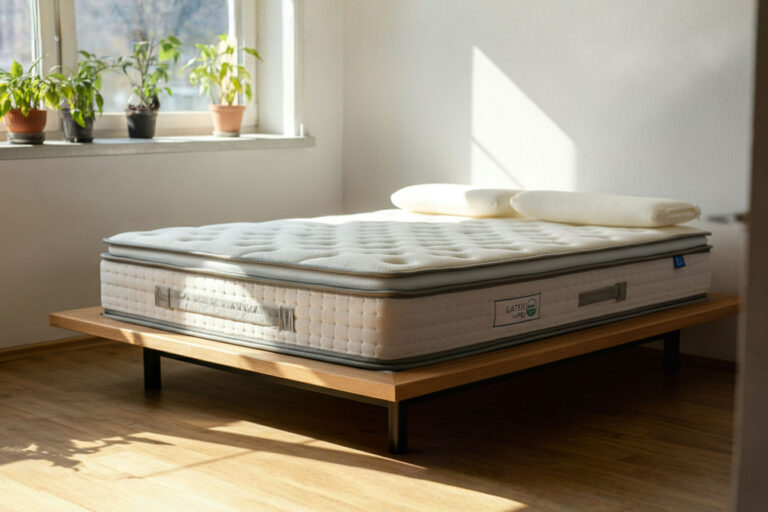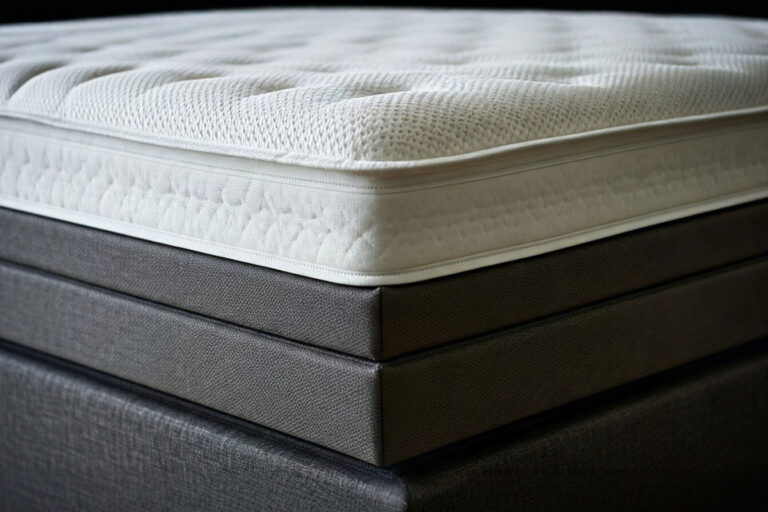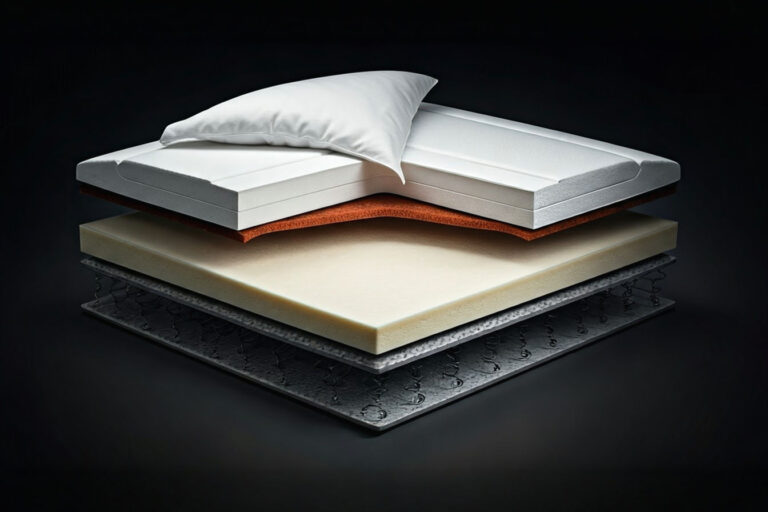Best Hybrid Bed Construction: Why Coil Count Matters Less Than You Think
Don’t be fooled by high coil counts! Discover the hidden factors in hybrid mattress construction that actually determine comfort, support, and durability.

This post may contain affiliate links. If you make a purchase through these links, we may earn a commission at no additional cost to you.
Choosing a new mattress can feel overwhelming, right? Walk into a store or browse online, and you’re hit with tons of terms and numbers. One number that often gets a lot of attention, especially with hybrid mattresses, is the coil count. Manufacturers sometimes highlight a high coil count as a sign of superior quality or support. But here’s a secret the mattress industry doesn’t always make clear: while coils are crucial, the sheer number of them isn’t the most important factor in how well a hybrid bed performs or how long it lasts.
This article will dive deep into what makes a great hybrid mattress. We’ll explain how these beds are built, explore the different parts, and show you why focusing only on the coil count can lead you to overlook what truly matters for comfort, support, and durability. By the end, you’ll understand exactly what to look for to find the best hybrid bed for you, moving beyond simple numbers to understand the quality and design that really count.
Understanding Hybrid Mattress Construction: More Than Just Springs and Foam
So, what exactly is a hybrid mattress? Think of it as the best of both worlds, combining the traditional support of an innerspring mattress with the contouring comfort of foam or latex. It’s a popular choice because it aims to give you the bounce and airflow of coils along with the pressure relief and motion isolation of specialized foams.
A typical hybrid mattress isn’t just a random stack of materials. It’s usually built in layers, each serving a specific purpose. Understanding these layers is key to seeing why coil count is only one piece of a larger puzzle.
Most hybrid mattresses have at least three main sections:
- The Support Core: This is the foundation, usually made up of a system of steel coils. Its main job is to provide overall structural support for the mattress and bear the majority of your body weight. It prevents you from sinking straight through the bed and helps maintain spinal alignment.
- The Transition Layer (or Layers): Situated right above the support core, this layer acts as a buffer. It provides a gradual transition from the firm support of the coils to the softer comfort layers above. This layer often uses denser foam or sometimes even smaller coils (like microcoils) to add contoured support and help distribute weight evenly before it reaches the main coil system.
- The Comfort Layer (or Layers): This is the top part of the mattress, the section you actually lie on. It’s designed for cushioning, pressure relief, and conforming to your body’s shape. Comfort layers are typically made from materials like memory foam, latex foam, or various types of polyfoam. These materials cradle your body, ease pressure points in areas like your shoulders and hips, and contribute to the overall feel of the mattress.
On top of the comfort layers, there’s usually a cover fabric, often quilted or made from breathable material, adding a final touch of softness and helping with temperature regulation.
The magic of a hybrid mattress comes from how these different layers work together. The coils provide the foundational support and responsiveness, while the foam layers add the plushness and body contouring. It’s this combination and the quality of each component that determine the mattress’s overall performance, not just how many coils are packed inside.
The Foundation: The Role of Coils in Hybrid Beds
The coil system is the engine of the hybrid mattress’s support. It’s what gives the bed its familiar bouncy feel and provides the primary pushback against your body weight. While the comfort layers get a lot of attention for how they feel initially, the coils are doing the heavy lifting to keep your spine properly aligned throughout the night.
Not all coils are created equal, and hybrid mattresses primarily use one specific type for their support core: pocketed coils.
- Pocketed Coils (or Individually Wrapped Coils): This is the most common type found in modern hybrid mattresses. Each coil is encased in its own fabric pocket. Because they aren’t directly connected to each other, they can move independently. This independent movement offers several key advantages:
- Targeted Support: Each coil can respond individually to the pressure applied to it. This means coils under your hips might compress more than those under your lighter lumbar region, allowing the mattress to contour more closely to your body’s curves.
- Reduced Motion Transfer: Since coils move independently, motion is isolated to the area where it occurs. If your partner tosses and turns, the movement is less likely to ripple across the entire mattress and disturb your sleep. This is a major upgrade from older innerspring systems where all coils were connected.
- Improved Contouring: The ability of individual coils to flex allows the mattress to hug your body’s shape better than interconnected coil systems.
While pocketed coils are standard in hybrids, it’s worth knowing about other coil types often found in traditional innerspring mattresses, as they highlight the benefits of the pocketed design:
- Bonnell Coils: These are the oldest and most basic type, shaped like an hourglass and connected by helical wires. They are durable and inexpensive but offer less contouring and poor motion isolation.
- Offset Coils: An improvement on Bonnell coils, they also have an hourglass shape but with flattened sections at the top and bottom that create a hinging effect. This allows for better contouring than Bonnell coils but they are still interconnected.
- Continuous Wire Coils: Made from a single piece of wire formed into rows of coils connected by helicals. They are very durable and stable but offer the least amount of contouring and high motion transfer.
Understanding that hybrid mattresses almost exclusively use the more advanced pocketed coil system is the first step in seeing why focusing only on the number of coils isn’t the full story. The type of coil is fundamentally important to the hybrid’s core benefits.
Coil Count: The Simple Metric That Gets Too Much Hype
Coil count is simply the total number of coils within a mattress. Manufacturers often list this number prominently in product descriptions, especially for queen-size mattresses (which serve as a common standard for comparison). You might see numbers ranging from 800 to over 2,000 coils in a queen-size hybrid.
It’s easy to understand why coil count became a popular marketing point. On the surface, it seems logical: more coils must mean more support, right? More springs to hold you up, more points of contact, surely that’s better? This simple logic resonates with consumers and provides an easy number to compare between different models or brands. It feels like a concrete measure of quality or density.
For a long time, especially with older innerspring mattresses, a higher coil count did generally correlate with better support and potentially durability, assuming the coil type and wire thickness were similar. More coils meant the load was distributed over a greater number of springs.
However, with the evolution of coil technology, particularly the widespread use of pocketed coils in hybrids, and advancements in foam technology, relying solely on coil count has become less reliable as an indicator of overall mattress quality or suitability for a sleeper. It’s a single data point in a much more complex system.
Beyond the Numbers: Factors More Important Than Coil Count
While coil count isn’t irrelevant – a mattress needs enough coils to provide adequate support – focusing on achieving the highest possible number is often misleading. There’s a point of diminishing returns where adding more coils doesn’t significantly improve performance and might even indicate compromises in other areas.
Several other factors related to the coils themselves, as well as the overall mattress design and materials, play a much more critical role in determining how a hybrid mattress feels, performs, and lasts. Ignoring these while fixating on coil count is a mistake.
Here are the elements that truly matter:
- Coil Type: As discussed, pocketed coils offer superior contouring and motion isolation compared to older interconnected systems. The presence of pocketed coils is far more important than simply the number of coils if they were, say, continuous wire.
- Coil Gauge: This refers to the thickness of the wire used to make the coils. It’s measured using a gauge number. Counter-intuitively, a lower gauge number means a thicker wire, and thus a firmer, more durable coil. A higher gauge number means a thinner wire, resulting in a softer, more flexible coil. The gauge significantly impacts the firmness and support level provided by the coil layer.
- Coil Height: Taller coils generally allow for more compression and can contribute to a more responsive feel. However, the ideal height depends on the overall mattress design and the thickness of the other layers.
- Coil Zoning: Many high-quality hybrid mattresses feature zoned coil systems. This means the coils are arranged in sections with different firmness levels (achieved through varying coil gauge, height, or pre-compression). Zoning provides targeted support to different areas of your body, offering firmer support under heavier sections like the hips and lumbar region, and softer support under lighter areas like the shoulders.
- Quality of Materials: The type and density of the foam layers, the quality of the steel used for the coils, the durability of the fabric pockets, and the overall construction methods are paramount. High-quality materials, even with a moderate coil count, will outperform a mattress with a very high coil count but made with cheap, low-density foams or thin-gauge wire.
- Overall Construction and Layer Integration: How well the different layers are designed to work together is crucial. The transition layer needs to effectively distribute weight to the coil system. The comfort layers must provide adequate pressure relief without allowing you to sink too far and negate the coil support. The way the mattress is assembled impacts its durability and stability.
Focusing on just the coil count ignores these critical design and material considerations that have a much bigger impact on your sleep experience.
Coil Design and Gauge: The Real Strength of the Springs
Let’s dig a bit deeper into coil design and gauge, as these are fundamental to the coil layer’s performance.
As we covered, pocketed coils are the standard in hybrids because they move independently. This independent movement is a key part of how a hybrid contours to your body and minimizes motion transfer. Without this design feature, even a mattress with thousands of coils would behave like an old-fashioned bouncy bed, transferring motion everywhere.
Coil Gauge Explained:
Coil gauge is a measure of the wire’s thickness. The system uses numbers where a lower number indicates a thicker wire, and a higher number indicates a thinner wire.
- Lower Gauge (e.g., 12-13 gauge): These are thicker, stronger wires. Coils made from lower gauge wire are firmer and more durable. They provide robust support and are often used in the main support sections of the coil layer or in zoned areas requiring extra firmness, such as the lumbar region or edges for edge support. A mattress primarily using low-gauge coils will feel firmer overall.
- Higher Gauge (e.g., 14-15 gauge): These are thinner, more flexible wires. Coils made from higher gauge wire are softer and more easily compressed. They contribute to a more plush feel and are often used in comfort or transition layers (as microcoils) or in zoned areas designed for pressure relief, like under the shoulders. A mattress using higher-gauge coils will feel softer.
The gauge of the coils directly influences the firmness and resilience of the support layer. A mattress with a moderate number of thick, low-gauge coils might offer better support and durability than a mattress with a very high number of thin, high-gauge coils, especially for heavier individuals.
Think of it like building a structure: would you rather have a few strong, thick pillars or many thin, flimsy ones? The thicker pillars (lower gauge) provide a more stable and durable foundation.
Furthermore, the shape and tempering (heat treatment process) of the coil also affect its performance and longevity. Well-tempered steel coils maintain their shape and resilience longer, resisting sagging over time.
So, instead of just asking “How many coils?”, a more informed question is “What type of coils are used, what is their gauge, and how are they designed?”
Targeted Support: The Power of Coil Zoning
Another crucial factor that often gets overlooked in the focus on total coil count is coil zoning. This is a sophisticated design technique used in many higher-quality hybrid mattresses to provide tailored support to different areas of your body.
Our bodies don’t apply pressure evenly across the mattress. Our hips and shoulders are typically heavier and wider than our waist and legs. A mattress that provides uniform support across its entire surface might not adequately support the lumbar region (the curve in your lower back) while allowing the hips to sink too deeply, leading to spinal misalignment and discomfort.
Zoning addresses this by dividing the coil layer into distinct sections, or zones, each engineered to provide a different level of firmness or support. This is usually achieved by:
- Using different coil gauges in different zones (lower gauge for firmer zones, higher gauge for softer zones).
- Varying the height or shape of the coils.
- Using different tempering processes.
- Pre-compressing coils in certain zones.
A common zoning pattern involves 3, 5, or even 7 zones:
- 3-Zone: Often firmer in the center third (for hips and lumbar support) and slightly softer at the head and foot.
- 5-Zone: Typically includes firmer support for the hips and lumbar, softer zones for the shoulders and knees, and medium support for the head and feet.
- 7-Zone: Offers even more granular support, often with specific zones for the head, shoulders, upper back, lumbar, hips, thighs, and feet.
Why Zoning Matters More Than Just Count:
Imagine two queen-size mattresses, both with 1000 pocketed coils.
- Mattress A has a uniform coil system (all coils are the same gauge and tension).
- Mattress B has a zoned system with firmer coils in the center third and softer coils at the ends.
Even though they have the same coil count, Mattress B is likely to offer better spinal alignment and pressure relief because it’s designed to support your body’s natural shape more effectively. The firmer center zone prevents excessive hip sinkage, while the softer shoulder zone allows for better cushioning for side sleepers.
Zoning ensures that the support is distributed according to your body’s needs, leading to better spinal alignment and reduced pressure points. This targeted support is far more beneficial for overall sleep health and comfort than simply having a higher density of uniformly performing coils. A mattress with well-executed zoning and a moderate coil count is often superior to a non-zoned mattress with a much higher coil count.
The Comfort Equation: The Crucial Role of Foam and Other Layers
While the coil system provides the essential support structure and bounce in a hybrid mattress, the layers above the coils are equally critical to your comfort, pressure relief, and motion isolation. These comfort and transition layers, typically made of various foams or latex, work in tandem with the coils to create the overall feel and performance of the bed.
Ignoring the quality and properties of these layers while focusing solely on coil count is like judging a cake only by the quality of the flour – you’re missing all the other ingredients that make it taste good.
Common materials used in the comfort and transition layers include:
- Memory Foam: This viscoelastic foam is known for its ability to soften and conform to your body in response to heat and pressure. It provides excellent pressure relief by distributing weight evenly and cradling curves. It also excels at absorbing motion, making it great for couples. However, traditional memory foam can sometimes retain heat, though many modern hybrids use gel-infused or open-cell memory foam to improve airflow and cooling.
- Latex Foam: Derived from the sap of rubber trees (natural latex) or produced synthetically, latex is known for its buoyancy, durability, and responsiveness. It offers pressure relief but tends to push back more than memory foam, making it feel more “on top of” the mattress rather than sinking “into” it. Latex is naturally breathable and hypoallergenic, making it a good choice for those who sleep hot or have allergies.
- Polyfoam (Polyurethane Foam): This is a versatile foam that can be manufactured with varying densities and firmness levels. In hybrid mattresses, polyfoam is often used in the transition layer to provide a buffer between the coils and the comfort layers, or in the comfort layer itself, sometimes offering a more responsive feel than memory foam. The density of polyfoam is a key indicator of its quality and durability; higher density generally means a more durable and supportive foam.
How Foam Layers Work with Coils:
The interaction between the foam layers and the coil system is what defines the hybrid feel.
- The comfort layer provides the initial soft landing and pressure contouring.
- The transition layer helps to gradually transfer your weight to the coil system, preventing you from feeling the coils directly and ensuring smooth engagement of the springs.
- The coil support core provides the deep support and responsiveness.
The quality, density, thickness, and layering of these foam components significantly impact:
- Pressure Relief: How well the mattress cushions your body’s pressure points.
- Motion Isolation: How effectively movement is absorbed before it reaches your partner.
- Overall Firmness and Feel: The combination of foam firmness and coil support determines whether the mattress feels soft, medium, or firm.
- Durability: High-quality, dense foams resist sagging and body impressions over time, just like durable coils do.
A mattress with a very high coil count but thin, low-density foam layers might feel firm initially but could quickly develop uncomfortable pressure points or sag as the foam breaks down. Conversely, a mattress with a moderate coil count but thick, high-quality foam layers could offer superior comfort and longevity. The foam layers are not just padding; they are integral to the mattress’s function.
Holistic Construction: How Everything Works Together
Understanding the individual components of a hybrid mattress – the coil system, the transition layer, and the comfort layers – is important. But the true measure of a great hybrid bed lies in how these elements are integrated and the overall quality of the construction. A mattress is a system, and its performance depends on the synergy of its parts.
Think of building a house. You need a strong foundation (the coils), sturdy walls (the transition layer), and a protective roof with comfortable interiors (the comfort layers and cover). If any part is weak or poorly constructed, the whole structure suffers, regardless of how strong one single component might be.
In a hybrid mattress, this means:
- Proper Layering and Adhesion: The layers need to be securely bonded or assembled so they don’t shift or separate over time. Poor adhesion can lead to lumps, valleys, and a breakdown of the mattress structure.
- Edge Support: Many quality hybrid mattresses incorporate reinforced edge support. This is often achieved by using firmer, lower-gauge coils around the perimeter of the coil system or by encasing the coil unit in a frame of high-density foam (known as foam encapsulation). Good edge support prevents the feeling of rolling off the side, increases the usable sleeping surface, and makes it easier to sit on the edge of the bed. This is a construction feature independent of the total coil count in the center of the mattress.
- Material Compatibility: The materials used in different layers must be compatible and designed to work together. For example, the transition layer needs to be firm enough to prevent the comfort layer from pressing directly onto the coils but soft enough to allow the coils to contour.
- Overall Build Quality: This includes the quality of the stitching, the durability of the cover fabric, and the precision of the assembly. A well-built mattress feels solid and well-made, not flimsy.
A mattress with a high coil count but poor edge support, low-density foams that quickly degrade, or shoddy assembly will not provide the same level of comfort, support, or durability as a mattress with a moderate coil count, high-quality materials throughout, and robust construction.
The focus should shift from a single, easily marketable number like coil count to evaluating the mattress as a complete, integrated system. How do the coils, foams, and other materials work together to support your body, relieve pressure, and minimize motion transfer? That’s the question that leads to finding a truly great hybrid bed.
Marketing Hype vs. Practical Performance: Seeing Through the Numbers
The mattress industry, like many others, uses marketing to differentiate products and attract buyers. Coil count is an easy number to advertise and compare, which is why it often gets prominent placement in product descriptions and advertisements. It provides a seemingly objective metric in a purchase that is otherwise very subjective (comfort is personal!).
However, as we’ve explored, focusing only on this number is a classic example of marketing hype overshadowing practical performance. A high coil count can be a feature of a high-quality mattress, but it’s not a guarantee of quality on its own. It’s just one variable.
Think about car engines. A manufacturer could boast about having the highest number of cylinders, but the engine’s overall performance depends on many other factors: the displacement, the fuel injection system, the turbocharging (or lack thereof), the transmission, and the overall engineering. More cylinders don’t automatically mean a faster or more fuel-efficient car.
Similarly, a mattress with 2000 coils isn’t automatically better than one with 1000 coils. The 1000-coil mattress might use thicker wire (lower gauge), have superior zoning, incorporate higher-density foam layers, or feature better overall construction.
Savvy consumers need to look beyond the headline numbers. Don’t let a high coil count distract you from asking critical questions about the mattress’s other components and how they are designed to work together.
Manufacturers highlight coil count because it’s simple and sounds impressive. It’s much harder to market the nuances of coil gauge, zoning patterns, foam densities, or the specific benefits of a well-designed transition layer in a catchy advertisement. Your job as a buyer is to understand these underlying factors that truly contribute to a mattress’s performance and longevity.
Choosing Wisely: What to Evaluate Instead of Just High Coil Count
Now that you know why coil count isn’t the be-all and end-all, what should you look for when shopping for a hybrid mattress? Focus on evaluating the mattress based on a more holistic understanding of its construction and materials.
Here are the key factors to consider:
- Coil Type and Gauge: Confirm that the mattress uses pocketed coils for better motion isolation and contouring. While specific gauge numbers aren’t always advertised, look for descriptions that mention the firmness or support level provided by the coil layer. If possible, inquire about the gauge used, especially if you have specific firmness needs (lower gauge for firmer support).
- Coil Zoning: Does the mattress feature zoned support? Look for descriptions mentioning different support levels in different areas of the bed. This is a strong indicator of a design focused on proper spinal alignment and pressure relief.
- Quality and Type of Foam Layers: What materials are used in the comfort and transition layers? Are they memory foam, latex, polyfoam, or a combination? Look for information on foam density (especially for polyfoam, measured in pounds per cubic foot – lbs/cu ft). Higher density foams (e.g., 1.8 lbs/cu ft or higher for polyfoam, 3 lbs/cu ft or higher for memory foam) generally indicate better quality and durability. Understand the properties of each material and how they align with your preferences (e.g., memory foam for deep contouring, latex for responsiveness and cooling).
- Layer Thickness and Arrangement: Pay attention to the total height of the mattress and the thickness of the individual layers. A thicker comfort layer might offer more pressure relief, while a substantial transition layer is important for smooth support.
- Edge Support: Does the mattress have reinforced edge support? This is important for maximizing the usable sleeping surface and providing stability when sitting on the edge.
- Certifications: Look for certifications that indicate the materials have been tested for harmful chemicals. Common certifications include OEKO-TEX Standard 100 (tests for harmful substances in textiles) and CertiPUR-US (tests flexible polyurethane foams for emissions and harmful substances). These certifications speak to the safety and quality of the materials used.
- Warranty: A good warranty (typically 10 years or more) indicates the manufacturer’s confidence in the mattress’s durability and construction quality. Read the warranty terms carefully to understand what is covered (e.g., sagging depth).
- Reviews and Testimonials: Read reviews from other customers, paying attention to comments about long-term durability, sagging, support, and how the mattress performed for people with similar body types and sleeping positions.
- Trial Period and Return Policy: Many online mattress companies offer generous in-home trial periods (e.g., 100 nights or more). This allows you to test the mattress in your own home and ensure it’s the right fit for you. A good return policy is essential in case the mattress doesn’t meet your expectations.
By considering these factors together, you’ll get a much more accurate picture of a hybrid mattress’s quality and suitability than you would by simply comparing coil counts.
Conclusion: A Great Hybrid Bed is More Than Just Its Coil Count
In the world of hybrid mattresses, the number of coils is often presented as a primary indicator of quality and support. While coils are undoubtedly a vital component, the truth is that coil count matters less than you think. It’s a simple, marketable number that doesn’t tell the whole story about a mattress’s performance.
A truly great hybrid bed is the result of a well-engineered system where high-quality components work together seamlessly. The type of coil (pocketed is key for hybrids), the thickness of the wire (coil gauge), the strategic variation in support levels (coil zoning), the quality and density of the foam or latex layers, and the overall construction and integration of these elements are far more critical to how the mattress will feel, support your body, relieve pressure, isolate motion, and last over time.
Don’t fall into the trap of prioritizing a high coil count above all else. Instead, become an informed consumer by understanding the different layers and materials, looking for signs of quality construction like zoning and reinforced edges, checking for material certifications, and paying attention to what real users say in reviews.
Choosing the right mattress is an investment in your sleep health and overall well-being. By looking beyond the simple numbers and understanding the complex interplay of components, you’ll be much better equipped to find a hybrid mattress that provides the comfortable, supportive, and restful sleep you deserve, regardless of whether it has 800 or 2000 coils. Focus on the quality of the build, not just the quantity of the springs.





